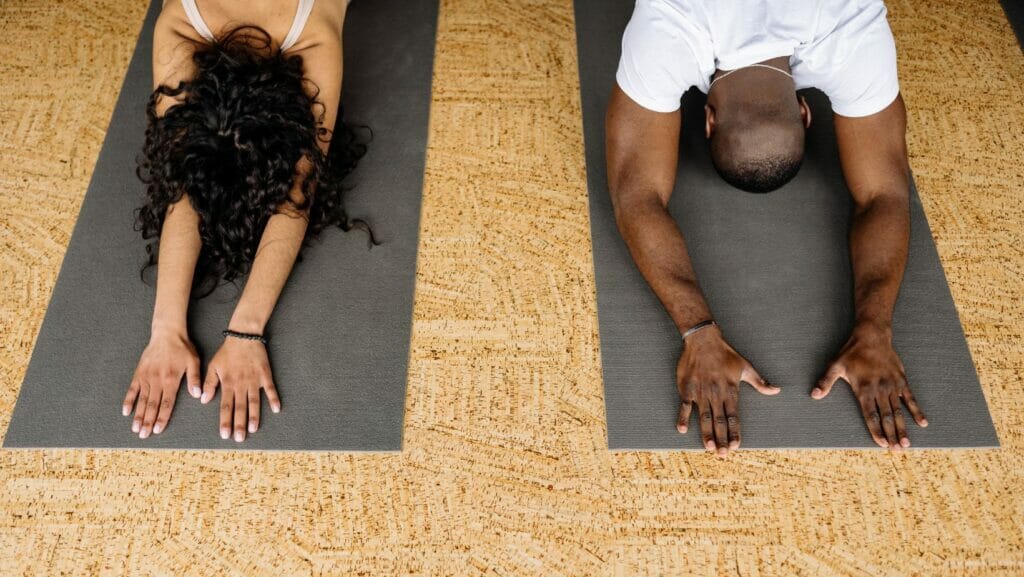
Restorative yoga is a practice that invites deep relaxation to counter the higher energy states we spend most of our days in. This therapeutic practice uses supported shapes and positions to invoke deep relaxation to settle your mind and bring harmony to your body.
In restorative yoga, we invite yoga props such as blocks, blankets, bolsters, straps, and sandbags to support the body in easing into a relaxed state. Counter to yang-based practices, like a vinyasa flow or ashtanga practice, restorative yoga practice is slow, grounding, and cooling. We are not aiming for a “deep stretch”. In fact, that stretch sensation we may feel in postures like a forward fold, a supine twist, and half pigeon, are signals that our nervous system is detecting an unfamiliar range of motion. In our restorative practice, we focus on cultivating our nervous system’s relaxation response. When our nervous system is in a relaxed state, our muscles are supported and sensations are gentle.
In sequencing a restorative practice, here are a few helpful things to note:
- Poses are held for an extended period of time, at least 20 minutes. This gives the body and mind plenty of time to ease into relaxation.
- Restorative practices are usually made up of 3 to 4 postures for a sixty-minute class
- Morning and evening are wonderful times to offer or integrate this grounding practice into your day. In the morning, our muscles are still cool and will gladly welcome the support of multiple props. In the evening, moving slowly and entering a relaxed state can support the mind and body into deep sleep.
Props you can use in a restorative yoga practice:
- 2-4 Blocks
- 1-2 Yoga bolsters and/or pillows
- Yoga strap
- 2-3 Blankets
- 1-2 Sandbags
- Eye pillow
The following is a basic list of poses you can start to build your practice with:
| Pose Name | Suggested Setup |
| Basic Relaxation PoseCan relieve lower back pain; encourages a feeling of grounding; softens psoas; supports natural and easy breathing. | The blanket behind the head; is folded at the base to support the neck. Bolster behind the kneesLoosely folded blanket to support the feet. |
| Simple Supported Side BendGently decompresses the spine; helps relieve lower back discomfort; invites natural deep breathing | Blanket underneath the head; folded at the base to support the neck with a bolster underneath the side body |
| Supported Open TwistGently decompresses the spine; gently opens chest, shoulders, and outer hip; invites gentle rotation to the spine | Bolster behind the arch of the back |
| Reclined Butterfly with Feet on BolsterGently opens the hips and lengthens inner thigh muscles; helps relieve hip pain or discomfort; can help relieve lower back tension | Blanket underneath the head; folded at the base to support the neck with a bolster underneath the ankles and shins |
| Supported Child’s PoseGently lengthens back muscles, glutes, and quads; helps relieve back pain; helps soothe anxiety; invites a feeling of calm and counters restlessness | Bolster and blankets to support the upper body. Blanket underneath the knees and shins |
| Open Heart PoseGently opens chest, shoulders, and front body; gently decompresses and lengthens the spine; can invite a soft boost of energy | Bolster, lengthwise, behind the back to lift the heart, lengthen the spine, and open the chest. |
| Supported BridgeCan gently relieve lower back tension, lengthens the spine, and can invite a feeling of lightness to the mind and body | Block with a blanket draped over it OR bolster to place underneath the sacrum |
| Legs up the WallSupported gentle inversion relieving pressure from legs and feet; soothing to the nervous system and overactive mind | Folded blanket to support the head; extra one to drape over the body. Bolster behind the natural arch of the spine |
Here, Michelle Young demonstrates some of the restorative options we’ve highlighted above using sandbags, blocks, bolsters, and blankets.
Remember, there is no wrong way to sequence a restorative yoga practice. You are creating a gentle and slow practice that over time and with consistent practice, can teach your mind and body how to rest safely. One of the most wonderful aspects of this practice is that it is accessible to anyone – it truly is an inclusive practice that can invite students to learn how to support themselves both on and off the mat.
